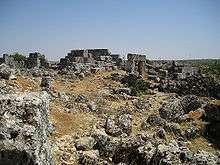Bara, Syria
Bara or al-Bara (Arabic: بارة) is one of the former "Dead Cities" in northwestern Syria. It is located in the Zawiya Mountain approximately 65 kilometres (40 mi) north from Hama and approx. 80 km southwest from Aleppo. Al-Bara is also town in Ariha district. According to the Syria Central Bureau of Statistics (CBS), al-Bara had a population of 10,353 in the 2004 census.[1]
بارة | |
 Ruins of Bara | |
 Shown within Syria | |
| Location | Idlib Governorate, Syria |
|---|---|
| Coordinates | 35.683°N 36.533°E |
| Type | settlement |
| Part of | Dead Cities |
| History | |
| Founded | 4th century AD |
| Abandoned | 12th century AD |
| Cultures | Byzantine |
| Site notes | |
| Condition | Ruins |
| Ownership | Public |
| Public access | Yes |
Al-Bara البارة | |
|---|---|
Village | |
| Country | |
| Governorate | Idlib Governorate |
| District | Ariha District |
| Nahiyah | Ihsim |
| Population (2004 census)[1] | |
| • Total | 10,353 |
| Time zone | UTC+2 (EET) |
| • Summer (DST) | UTC+3 (EEST) |
History
The settlement was established in the fourth century at an important trade route between Antioch and Apamea. Due to good location and excellent conditions to produce wine and olive oil, it flourished in the 5th and 6th centuries. When Muslims conquered the region and trading routes were disrupted and other Dead Cities were abandoned, Bara remained inhabited, most inhabitants remained Christians, and the town even became a seat of a bishopric subordinate of Antioch under Peter of Narbonne.[2]
In 1098, it was conquered by crusaders (from there they later set off to the infamous cannibalistic massacre of Ma`arat al-Numan) led by Raymond de Saint-Gilles. The town was taken by Ridwan in 1104 and retaken by Tancred a year later. However, it was retaken by Muslims from 1119 to 1122. In 1123, the town was reconquered by Belek Ghazi who built a small fortress. By 1130, it was retaken by the crusaders of Antioch until it was finally controlled by Nur ad-Din in 1148.[3] Later in the 12th century, after a severe earthquake, the town was abandoned.
Later, in the beginning of the 20th century, a modern village of the same name arose near the site of the ancient town and till today it has grown to the size of a small town.
Ruins are the most extensive of all Dead Cities and are scattered among fields, olive groves and orchards. Among many others, one can distinguish remains of at least five churches, three monasteries, several villas, two pyramidal tombs and one underground tomb.
References
- General Census of Population and Housing 2004 Archived 1 February 2016 at the Wayback Machine. Syria Central Bureau of Statistics (CBS). Idlib Governorate. (in Arabic)
- Westervelt, Eric (22 October 2008). "Al Bara And Serjilla: A Taste of Syria's 'Dead Cities'". npr.org. Retrieved 2 March 2018.
- Edmond Pottier; René Dussaud; Gaston Migeon (1948). Syria, Volume 25 (in French). High Commission of the French Republic in Syria and Lebanon, French Institute of Archaeology in Beirut. p. 106.
External links
- Simeon Citadel and Dead Cities, Suggestion to have al-Bara recognized as a UNESCO world heritage site, in 2006, as part of "Simeon Citadel and Dead Cities"-project.
- Syria Gate
- MiddleEast.com
- Tens of pictures of this dead city
| Wikimedia Commons has media related to Al-Bara. |
